Siemens HiPath 500, HiPath 3000, HiPath 5000 User Manual
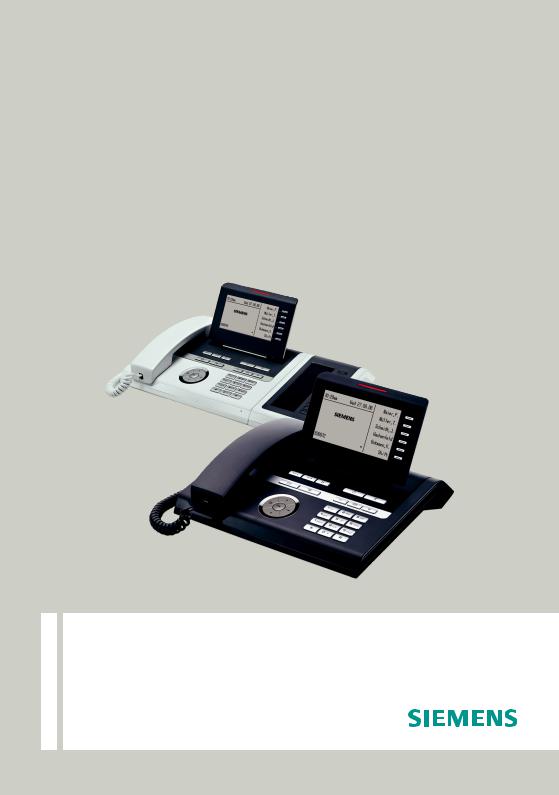
Documentation
HiPath 500, HiPath 3000, HiPath 5000 OpenStage 40 T
OpenStage Key Module 40 OpenStage Busy lamp field 40
User Guide
Communication for the open minded
Siemens Enterprise Communications www.siemens-enterprise.com
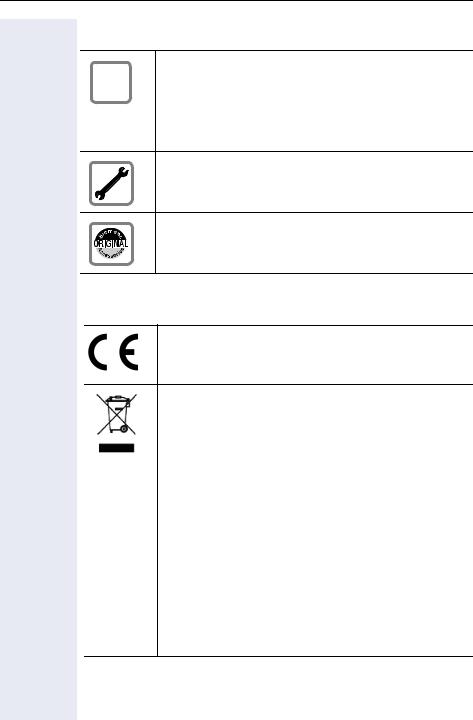
Important information
Important information
For safety reasons, the telephone should only be supplied
Qwith power (required in connection with an OpenStage key module Æ page 14Æ page 14Æ page 14,
Æ page 16Æ page 16):
•using the original power supply unit.
Part number: L30250-F600-C14x (x: 1=EU, 2=UK, 3=US).
Never open the telephone or a key module. Should you encounter any problems, contact the responsible service personnel.
Use only original Siemens accessories. The use of other accessories may be hazardous and will render the warranty, extended manufacturer’s liability and the CE marking invalid.
Trademarks
The device conforms to the EU directive 1999/5/EC as attested by the CE marking.
All electrical and electronic products should be disposed of separately from the municipal waste stream via designated collection facilities appointed by the government or the local authorities.
Proper disposal and separate collection of your old appliance will help prevent potential damage to the environment and human health. It is a prerequisite for reuse and recycling of used electrical and electronic equipment.
For more detailed information about disposal of your old appliance, please contact your city office, waste disposal service, the shop where you purchased the product or your sales representative.
The statements quoted above are only fully valid for equipment which is installed and sold in the countries of the European Union and is covered by the directive 2002/96/EC. Countries outside the European Union may impose other regulations regarding the disposal of electrical and electronic equipment.
2

Important information
Location of the telephone
•The telephone should be operated in a controlled environment with an ambient temperature between 5•C and 40•C.
•To ensure good speakerphone quality, the area in front of the microphone (front right) should be kept clear. The optimum speakerphone distance is 50 cm.
•Do not install the telephone in a room where large quantities of dust accumulate; this can considerably reduce the service life of the telephone.
•Do not expose the telephone to direct sunlight or any other source of heat, as this is liable to damage the electronic components and the plastic casing.
•Do not operate the telephone in damp environments such as bathrooms.
Product support on the internet
Information and support for our products can be found on the Internet at: http://siemens-enterprise.com/.
Technical notes, current information about firmware updates, frequently asked questions and lots more can be found on the Internet at: http://wiki.siemens-enterprise.com/.
3

Contents
Contents
Important information . . . . . . . . . . . . . . . . . . . . . . . . . .2
Trademarks . . . . . . . . . . . . . . . . . . . . . . . . . . . . . . . . . . . . . . . . . . . . . . . 2 Location of the telephone . . . . . . . . . . . . . . . . . . . . . . . . . . . . . . . . . . . . 3 Product support on the internet . . . . . . . . . . . . . . . . . . . . . . . . . . . . . . . 3
General information. . . . . . . . . . . . . . . . . . . . . . . . . . .10
About this manual . . . . . . . . . . . . . . . . . . . . . . . . . . . . . . . . . . . . . . . . . 10 Service. . . . . . . . . . . . . . . . . . . . . . . . . . . . . . . . . . . . . . . . . . . . . . . . . . 10 Intended use . . . . . . . . . . . . . . . . . . . . . . . . . . . . . . . . . . . . . . . . . . . . . 11 Telephone type . . . . . . . . . . . . . . . . . . . . . . . . . . . . . . . . . . . . . . . . . . . 11 Speakerphone quality and display legibility . . . . . . . . . . . . . . . . . . . . . . 11 Multi-line telephone, executive/secretary functions . . . . . . . . . . . . . . . 11
Team functions . . . . . . . . . . . . . . . . . . . . . . . . . . . . . . . . . . . . . . . . 11
Getting to know your OpenStage phone . . . . . . . . .12
The User Interface of Your OpenStage 40 T . . . . . . . . . . . . . . . . . . . . . 12 Ports on the underside of the phone. . . . . . . . . . . . . . . . . . . . . . . . . . . 13 Key Module . . . . . . . . . . . . . . . . . . . . . . . . . . . . . . . . . . . . . . . . . . . . . . 14 OpenStage Key Module 40 . . . . . . . . . . . . . . . . . . . . . . . . . . . . . . . 14 OpenStage Key Module 15 . . . . . . . . . . . . . . . . . . . . . . . . . . . . . . . 15 OpenStage Busy lamp field 40 . . . . . . . . . . . . . . . . . . . . . . . . . . . . . . . 16 Keys. . . . . . . . . . . . . . . . . . . . . . . . . . . . . . . . . . . . . . . . . . . . . . . . . . . . 17 Function keys. . . . . . . . . . . . . . . . . . . . . . . . . . . . . . . . . . . . . . . . . . 17 Audio keys . . . . . . . . . . . . . . . . . . . . . . . . . . . . . . . . . . . . . . . . . . . . 17 5-way navigator . . . . . . . . . . . . . . . . . . . . . . . . . . . . . . . . . . . . . . . . 18 Programmable sensor keys . . . . . . . . . . . . . . . . . . . . . . . . . . . . . . . 19 Keypad . . . . . . . . . . . . . . . . . . . . . . . . . . . . . . . . . . . . . . . . . . . . . . . 20 Display. . . . . . . . . . . . . . . . . . . . . . . . . . . . . . . . . . . . . . . . . . . . . . . . . . 22 Idle mode. . . . . . . . . . . . . . . . . . . . . . . . . . . . . . . . . . . . . . . . . . . . . 22 Telephony dialogs . . . . . . . . . . . . . . . . . . . . . . . . . . . . . . . . . . . . . . 24 Mailbox . . . . . . . . . . . . . . . . . . . . . . . . . . . . . . . . . . . . . . . . . . . . . . . . . 26 Messages . . . . . . . . . . . . . . . . . . . . . . . . . . . . . . . . . . . . . . . . . . . . 26 Voicemail . . . . . . . . . . . . . . . . . . . . . . . . . . . . . . . . . . . . . . . . . . . . . 26 Caller list . . . . . . . . . . . . . . . . . . . . . . . . . . . . . . . . . . . . . . . . . . . . . . . . 27 Menu . . . . . . . . . . . . . . . . . . . . . . . . . . . . . . . . . . . . . . . . . . . . . . . . . . . 28 Program/Service menu . . . . . . . . . . . . . . . . . . . . . . . . . . . . . . . . . . 28 Call preparation . . . . . . . . . . . . . . . . . . . . . . . . . . . . . . . . . . . . . . . . 29 Call pop-up . . . . . . . . . . . . . . . . . . . . . . . . . . . . . . . . . . . . . . . . . . . . 30 Audio accessories . . . . . . . . . . . . . . . . . . . . . . . . . . . . . . . . . . . . . . 31
4

Contents
Basic functions . . . . . . . . . . . . . . . . . . . . . . . . . . . . . . 32
Answering a call . . . . . . . . . . . . . . . . . . . . . . . . . . . . . . . . . . . . . . . . . . 32 Answering a call via the handset . . . . . . . . . . . . . . . . . . . . . . . . . . . 32 Answering a call via the loudspeaker (speakerphone mode) . . . . . . 33 Accepting a call via the headset. . . . . . . . . . . . . . . . . . . . . . . . . . . . 33 Switching to speakerphone mode. . . . . . . . . . . . . . . . . . . . . . . . . . . . . 34 Switching to the handset. . . . . . . . . . . . . . . . . . . . . . . . . . . . . . . . . . . . 34 Open listening during a call . . . . . . . . . . . . . . . . . . . . . . . . . . . . . . . . . . 34 Making calls. . . . . . . . . . . . . . . . . . . . . . . . . . . . . . . . . . . . . . . . . . . . . . 35 Off-hook dialing . . . . . . . . . . . . . . . . . . . . . . . . . . . . . . . . . . . . . . . . 35 On-hook dialing . . . . . . . . . . . . . . . . . . . . . . . . . . . . . . . . . . . . . . . . 35 Dialing with the headset connected . . . . . . . . . . . . . . . . . . . . . . . . 36 Dialing with DDS keys . . . . . . . . . . . . . . . . . . . . . . . . . . . . . . . . . . . 36 Redialing a number . . . . . . . . . . . . . . . . . . . . . . . . . . . . . . . . . . . . . . . . 37 Ending a call. . . . . . . . . . . . . . . . . . . . . . . . . . . . . . . . . . . . . . . . . . . . . . 38 Rejecting calls . . . . . . . . . . . . . . . . . . . . . . . . . . . . . . . . . . . . . . . . . . . . 38 Turning the microphone on and off . . . . . . . . . . . . . . . . . . . . . . . . . . . . 38 Calling a second party (consultation) . . . . . . . . . . . . . . . . . . . . . . . . . . . 39 Switching to the held party (alternating) . . . . . . . . . . . . . . . . . . . . . 39 Transferring a call. . . . . . . . . . . . . . . . . . . . . . . . . . . . . . . . . . . . . . . 40 Call forwarding. . . . . . . . . . . . . . . . . . . . . . . . . . . . . . . . . . . . . . . . . . . . 41 Using variable call forwarding . . . . . . . . . . . . . . . . . . . . . . . . . . . . . 41 Using call forwarding no reply (CFNR) . . . . . . . . . . . . . . . . . . . . . . . 42
Call forwarding in the carrier network and
forwarding multiple subscriber numbers (MSN) (not for U.S.). . . . . 43 Using callback . . . . . . . . . . . . . . . . . . . . . . . . . . . . . . . . . . . . . . . . . . . . 44 Storing a callback . . . . . . . . . . . . . . . . . . . . . . . . . . . . . . . . . . . . . . . 44 Accepting a callback. . . . . . . . . . . . . . . . . . . . . . . . . . . . . . . . . . . . . 44 Viewing and deleting a stored callback . . . . . . . . . . . . . . . . . . . . . . 45
5

Contents
Enhanced phone functions. . . . . . . . . . . . . . . . . . . . .46
Answering calls . . . . . . . . . . . . . . . . . . . . . . . . . . . . . . . . . . . . . . . . . . . 46 Accepting a call with the headset . . . . . . . . . . . . . . . . . . . . . . . . . . 46 Accepting a specific call for your colleague . . . . . . . . . . . . . . . . . . . 46 Using the speakerphone . . . . . . . . . . . . . . . . . . . . . . . . . . . . . . . . . 47 Answering calls from the entrance telephone
and opening the door. . . . . . . . . . . . . . . . . . . . . . . . . . . . . . . . . . . . 48 Accepting a call from an answering machine . . . . . . . . . . . . . . . . . 49 Making calls. . . . . . . . . . . . . . . . . . . . . . . . . . . . . . . . . . . . . . . . . . . . . . 50 En-bloc sending/correcting numbers . . . . . . . . . . . . . . . . . . . . . . . . 50 Using the caller list . . . . . . . . . . . . . . . . . . . . . . . . . . . . . . . . . . . . . 51 Dialing a number from the internal directory . . . . . . . . . . . . . . . . . . 52 Using the LDAP directory (not for HiPath 500) . . . . . . . . . . . . . . . . 53 Making calls using system speed-dial numbers . . . . . . . . . . . . . . . 55 Dialing with speed-dial keys . . . . . . . . . . . . . . . . . . . . . . . . . . . . . . 55 Talking to your colleague with a speaker call. . . . . . . . . . . . . . . . . . 56 Talking to your colleague with discreet calling (not for HiPath 500) 57 Automatic connection setup (hotline) . . . . . . . . . . . . . . . . . . . . . . . 57 Reserving a trunk. . . . . . . . . . . . . . . . . . . . . . . . . . . . . . . . . . . . . . . 57 Assigning a station number (not for U.S.) . . . . . . . . . . . . . . . . . . . . 58 Associated dialing/dialing aid . . . . . . . . . . . . . . . . . . . . . . . . . . . . . . 58 During a call . . . . . . . . . . . . . . . . . . . . . . . . . . . . . . . . . . . . . . . . . . . . . . 60 Using call waiting (second call) . . . . . . . . . . . . . . . . . . . . . . . . . . . . 60 Preventing and allowing call waiting (automatic camp-on) . . . . . . . 61 Turning the call waiting tone on and off. . . . . . . . . . . . . . . . . . . . . . 61 Saving a number . . . . . . . . . . . . . . . . . . . . . . . . . . . . . . . . . . . . . . . 61 Parking a call . . . . . . . . . . . . . . . . . . . . . . . . . . . . . . . . . . . . . . . . . . 62 Holding external calls. . . . . . . . . . . . . . . . . . . . . . . . . . . . . . . . . . . . 63 Conducting a conference. . . . . . . . . . . . . . . . . . . . . . . . . . . . . . . . . 64 Activating tone dialing/DTMF suffix-dialing . . . . . . . . . . . . . . . . . . . 65 Recording a call . . . . . . . . . . . . . . . . . . . . . . . . . . . . . . . . . . . . . . . . 67 Transferring a call after a speaker call announcement in a group . . 68 Send trunk flash (not for HiPath 500). . . . . . . . . . . . . . . . . . . . . . . . 69 If you cannot reach a destination. . . . . . . . . . . . . . . . . . . . . . . . . . . . . . 70 Call waiting (camp-on) . . . . . . . . . . . . . . . . . . . . . . . . . . . . . . . . . . . 70 Busy override – joining a call in progress. . . . . . . . . . . . . . . . . . . . . 70
Using night answer . . . . . . . . . . . . . . . . . . . . . . . . . . . . . . . . . . . . . . . . 71 Programming a sensor key . . . . . . . . . . . . . . . . . . . . . . . . . . . . . . . . . . 72 Configuring function keys . . . . . . . . . . . . . . . . . . . . . . . . . . . . . . . . . . . 72 Overview of functions . . . . . . . . . . . . . . . . . . . . . . . . . . . . . . . . . . . 73 Programming a procedure key . . . . . . . . . . . . . . . . . . . . . . . . . . . . . . . 75 Configuring repdial keys . . . . . . . . . . . . . . . . . . . . . . . . . . . . . . . . . . . . 77 Changing the label. . . . . . . . . . . . . . . . . . . . . . . . . . . . . . . . . . . . . . . . . 78 Deleting sensor key programming . . . . . . . . . . . . . . . . . . . . . . . . . . . . 79
6

Contents
Displaying and assigning call charges . . . . . . . . . . 80
Displaying call charges (not for U.S.) . . . . . . . . . . . . . . . . . . . . . . . . . . . 80 Displaying call charges for another telephone (not for U.S.) . . . . . . . . . 81 Dialing with call charge assignment . . . . . . . . . . . . . . . . . . . . . . . . . . . 82
Privacy/security . . . . . . . . . . . . . . . . . . . . . . . . . . . . . . 83
Turning ringer cutoff on and off. . . . . . . . . . . . . . . . . . . . . . . . . . . . . . . 83 Activating/deactivating "Do not disturb". . . . . . . . . . . . . . . . . . . . . . . . . 83 Caller ID suppression. . . . . . . . . . . . . . . . . . . . . . . . . . . . . . . . . . . . . . . 84 Silent Monitor (not for HiPath 500) . . . . . . . . . . . . . . . . . . . . . . . . . . . . 84 Monitoring a room . . . . . . . . . . . . . . . . . . . . . . . . . . . . . . . . . . . . . . . . . 85 Trace call: identifying anonymous callers (not for U.S.) . . . . . . . . . . . . . 85 Locking the telephone to prevent unauthorized use . . . . . . . . . . . . . . . 86 Locking another telephone to prevent unauthorized use . . . . . . . . . . . 87 Saving your PIN . . . . . . . . . . . . . . . . . . . . . . . . . . . . . . . . . . . . . . . . . . . 88
More functions/services . . . . . . . . . . . . . . . . . . . . . . 89
Appointments function . . . . . . . . . . . . . . . . . . . . . . . . . . . . . . . . . . . . . 89 Saving appointments . . . . . . . . . . . . . . . . . . . . . . . . . . . . . . . . . . . . 89 Using timed reminders . . . . . . . . . . . . . . . . . . . . . . . . . . . . . . . . . . 90 Sending a message . . . . . . . . . . . . . . . . . . . . . . . . . . . . . . . . . . . . . . . . 90 Creating and sending a message. . . . . . . . . . . . . . . . . . . . . . . . . . . 90 Viewing and editing incoming messages. . . . . . . . . . . . . . . . . . . . . 91 Leaving an advisory message . . . . . . . . . . . . . . . . . . . . . . . . . . . . . . . . 92 Deleting advisory messages . . . . . . . . . . . . . . . . . . . . . . . . . . . . . . 92 Displaying the number of waiting calls/overload display . . . . . . . . . . . . 93 Using another telephone like your own for a call. . . . . . . . . . . . . . . . . . 93 Fax details and message on answering machine . . . . . . . . . . . . . . . . . 95
Resetting services and functions
(system-wide cancellation for a telephone) . . . . . . . . . . . . . . . . . . . . . . 95 Activating functions for another telephone . . . . . . . . . . . . . . . . . . . . . . 96 Using system functions from outside
DISA (direct inward system access) . . . . . . . . . . . . . . . . . . . . . . . . . . . 97 Using functions in ISDN via code dialing (keypad dialing) . . . . . . . . . . . 98 Controlling connected computers/programs/telephone data service . . 99 Communicating with PC applications over a CSTA interface . . . . . . . 100 Controlling relays (only for HiPath 3000) . . . . . . . . . . . . . . . . . . . . . . . 101 Sensors (HiPath 33x0/35x0 only). . . . . . . . . . . . . . . . . . . . . . . . . . . . . 101 Paging persons (not for USA, not for HiPath 500) . . . . . . . . . . . . . . . . 102
7

Contents
Making calls in the team/executive/
secretary configuration . . . . . . . . . . . . . . . . . . . . . .103
Lines . . . . . . . . . . . . . . . . . . . . . . . . . . . . . . . . . . . . . . . . . . . . . . . . . . 103 Line utilization . . . . . . . . . . . . . . . . . . . . . . . . . . . . . . . . . . . . . . . . 103 Line seizure . . . . . . . . . . . . . . . . . . . . . . . . . . . . . . . . . . . . . . . . . . 104 Trunk keys . . . . . . . . . . . . . . . . . . . . . . . . . . . . . . . . . . . . . . . . . . . . . . 104 Answering calls with the trunk keys . . . . . . . . . . . . . . . . . . . . . . . 105 Dialing with trunk keys. . . . . . . . . . . . . . . . . . . . . . . . . . . . . . . . . . 105 Placing a call on hold on a trunk key and retrieving the held call . . 105 Making calls on multiple lines alternately . . . . . . . . . . . . . . . . . . . 106 MULAP conference release. . . . . . . . . . . . . . . . . . . . . . . . . . . . . . 106 Direct station selection key . . . . . . . . . . . . . . . . . . . . . . . . . . . . . . . . . 107 Using DSS keys to answer calls . . . . . . . . . . . . . . . . . . . . . . . . . . 107 Calling a team member directly . . . . . . . . . . . . . . . . . . . . . . . . . . . 107 Transferring a call in progress . . . . . . . . . . . . . . . . . . . . . . . . . . . . 108 Accepting a call for another team member . . . . . . . . . . . . . . . . . . 108 Forwarding calls on trunks . . . . . . . . . . . . . . . . . . . . . . . . . . . . . . . . . 109 Transferring calls directly to the executive phone . . . . . . . . . . . . . . . . 111
Using team functions. . . . . . . . . . . . . . . . . . . . . . . . .112
Activating/deactivating a group call . . . . . . . . . . . . . . . . . . . . . . . . . . . 112 Accepting a call for another member of your team . . . . . . . . . . . . . . . 114 Ringing group . . . . . . . . . . . . . . . . . . . . . . . . . . . . . . . . . . . . . . . . . . . 114 Uniform Call Distribution (UCD). . . . . . . . . . . . . . . . . . . . . . . . . . . . . . 115
Special functions in the LAN
(not for HiPath 500). . . . . . . . . . . . . . . . . . . . . . . . . . .117
Leaving hunt group/group call . . . . . . . . . . . . . . . . . . . . . . . . . . . . . . . 117 Setting up "follow me" call forwarding. . . . . . . . . . . . . . . . . . . . . . . . . 118 Using night answer . . . . . . . . . . . . . . . . . . . . . . . . . . . . . . . . . . . . . . . 119 Ringing group . . . . . . . . . . . . . . . . . . . . . . . . . . . . . . . . . . . . . . . . . . . 120 Controlling relays (only for HiPath 3000) . . . . . . . . . . . . . . . . . . . . . . . 121 Opening a door . . . . . . . . . . . . . . . . . . . . . . . . . . . . . . . . . . . . . . . . . . 122
8

Contents
Individual phone configuration . . . . . . . . . . . . . . . 123
Adjusting display settings . . . . . . . . . . . . . . . . . . . . . . . . . . . . . . . . . . 123 Adjusting the display to a comfortable reading angle . . . . . . . . . . 123 Illuminated display . . . . . . . . . . . . . . . . . . . . . . . . . . . . . . . . . . . . . 123 Setting contrast . . . . . . . . . . . . . . . . . . . . . . . . . . . . . . . . . . . . . . . 123 Adjusting displays on the Open Stage Key Module . . . . . . . . . . . . . . 123 Adjusting audio settings . . . . . . . . . . . . . . . . . . . . . . . . . . . . . . . . . . . 124 Adjusting the attention ring volume. . . . . . . . . . . . . . . . . . . . . . . . 125 Adjusting the speakerphone to the room acoustics . . . . . . . . . . . 125 Activating/deactivating the ringer. . . . . . . . . . . . . . . . . . . . . . . . . . 125 Language for system functions . . . . . . . . . . . . . . . . . . . . . . . . . . . . . . 125
Testing the phone . . . . . . . . . . . . . . . . . . . . . . . . . . . 126
Phone functions, testing . . . . . . . . . . . . . . . . . . . . . . . . . . . . . . . . . . . 126 Checking the key assignment . . . . . . . . . . . . . . . . . . . . . . . . . . . . . . . 126
Differing display view in a HiPath 4000 environment (not for HiPath 500) . . . . . . . . . . . . . . . . . . . . . . . . . . 127
Fixing problems . . . . . . . . . . . . . . . . . . . . . . . . . . . . . 128
Responding to error messages on the screen . . . . . . . . . . . . . . . . . . 128 Contact partner in the case of problems . . . . . . . . . . . . . . . . . . . . . . . 129 Troubleshooting. . . . . . . . . . . . . . . . . . . . . . . . . . . . . . . . . . . . . . . . . . 130 Caring for your telephone . . . . . . . . . . . . . . . . . . . . . . . . . . . . . . . . . . 130
Index . . . . . . . . . . . . . . . . . . . . . . . . . . . . . . . . . . . . . . 131 Overview of functions and codes. . . . . . . . . . . . . . 136 Display icons . . . . . . . . . . . . . . . . . . . . . . . . . . . . . . . 141
9
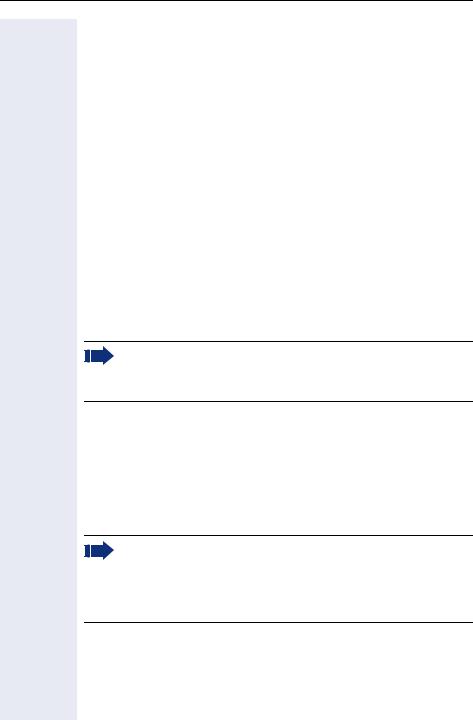
General information
General information
About this manual
This document contains general descriptions of the technical options, which may not always be available in individual cases. The respective features must therefore be individually defined in the terms of the contract.
If a particular function on your phone is not available to you, this may be due to one of the following reasons:
•The function is not configured for you or your telephone. Please contact your system support representative.
•Your communications platform does not feature this function. Please contact your Siemens sales partner for information on how to upgrade.
This user guide is intended to help you familiarize yourself with OpenStage and all of its functions. It contains important information on the safe and proper operation of your OpenStage phone. These instructions should be strictly complied with to avoid operating errors and ensure optimum use of your multifunctional telephone in the network.
These instructions should be read and followed by every person installing, operating or programming an OpenStage phone.
For your own protection, please read the section dealing with safety in detail. Follow the safety instructions carefully in order to avoid endangering yourself or other persons and to prevent damage to the unit.
This user guide is designed to be simple and easy to understand, providing clear step-by-step instructions for operating your OpenStage phone.
Administrative tasks are dealt with in a separate manual. The Quick Reference Guide contains quick and reliable explanations of frequently used functions.
Service
The Siemens service department can only help you if you experience problems or defects with the phone.
Should you have any questions regarding operation, your specialist retailer or network administrator will gladly help you.
For queries regarding connection of the telephone, please contact your network provider.
If you experience problems or defects with the phone, please dial the service number for your country.
10

General information
Intended use
The OpenStage phone was developed as a device for speech transmission and should be placed on the desk or mounted on the wall. Any other use is regarded as unauthorized.
Telephone type
The identification details (exact product designation and serial number) of your telephone can be found on the nameplate on the underside of the base unit. Specific details concerning your communications platform can be obtained from your service technician.
Please have this information ready when you contact our service department regarding faults or problems with the product.
Speakerphone quality and display legibility
•To ensure good speakerphone quality, the area in front of the telephone (front right) should be kept clear.
The optimum handsfree distance is 20 in. (50 cm).
•Proceed as follows to optimize display legibility:
–Turn the phone to tilt the display. This ensures you have a frontal view of the display while eliminating light reflexes.
Multi-line telephone, executive/secretary functions
Your OpenStage 40 T is a "multi-line telephone". This means that your service personnel can configure multiple lines on your phone, which is not the case with single-line phones. Each line is assigned an individual phone number which you can use to make and receive calls.
The programmable sensor keys function as line keys on multi-line phones Æ page 104.
When using a multi-line phone to make and receive calls, certain particulars must be taken into account Æ page 105 ff.
The executive-secretary configuration is a special case. This is a multi-line telephone with special features (e.g., "Ring Transfer" and "Accept call"), configured especially for executive/secretary use Æ page 103 ff.
Team functions
To increase the efficiency of telephony, your service personnel can configure various Team functions such as pickup groups, hunt groups, and call distribution groups.
11
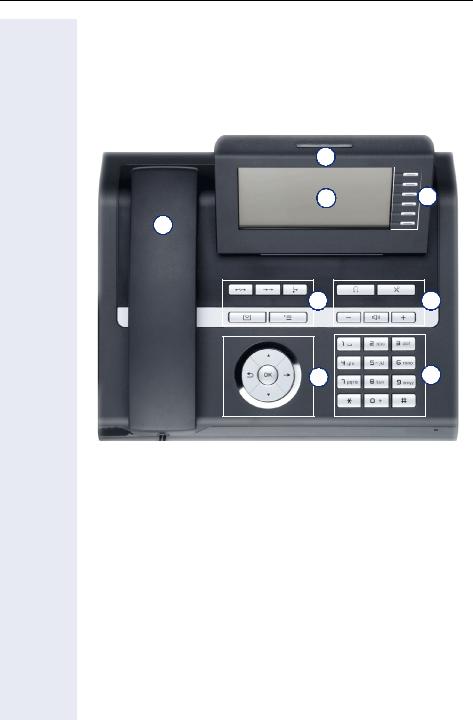
Getting to know your OpenStage phone
Getting to know your OpenStage phone
The following sections describe the most frequently used operating elements and the displays on your OpenStage phone.
The User Interface of Your OpenStage 40 T
8
2 |
3 |
1
4 |
5 |
6 |
7 |
1 |
You can make and receive calls as normal using the handset. |
|
|
2 |
The display permits intuitive operation of the phone Æ page 22. |
|
|
3 |
You can customize your telephone by assigning phone numbers and |
|
functions to the programmable sensor keys Æ page 19. |
|
|
4 |
You can use function keys when conducting a call to access frequent- |
|
ly used functions (such as, Disconnect) or to open the Program/Ser- |
|
vice menu and mailbox Æ page 17. |
|
|
5 |
Audio keys are also available, allowing you to optimally configure the |
|
audio features on your telephone Æ page 17. |
|
|
6 |
The 5-way navigator is a convenient navigation tool Æ page 18. |
|
|
7 |
The keypad can be used to enter phone numbers and text |
|
Æ page 20. |
|
|
8 |
Incoming calls are visually signaled via the call display. |
|
|
12

Getting to know your OpenStage phone
Ports on the underside of the phone
HiPath 
USB slave
Headset 
Busy Lamp field
key module |
Handset |
|||
|
|
|||
|
|
|
|
|
|
|
|
|
|
Properties of your OpenStage 40 T
Display type |
LCD, 40 x 6 characters |
|
|
Illuminated display |
; |
Programmable sensor keys |
6 |
|
|
Full-duplex speakerphone function |
; |
Headset |
; |
USB slave |
; |
Phone/analog adapter |
; |
Interface for key modules |
; |
Wall mounting |
; |
13
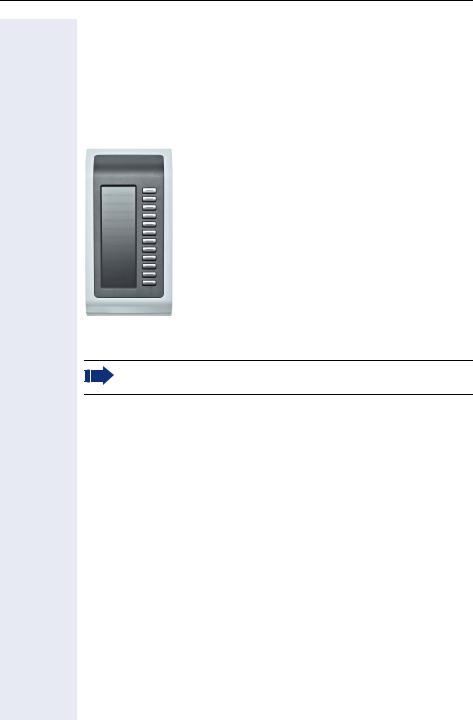
Getting to know your OpenStage phone
Key Module
OpenStage Key Module 40
The OpenStage Key Module 40 is a key module attached to the side of the phone that provides 12 additional illuminated, programmable keys.
Like keys on the phone, these keys can be programmed and used according to your needs Æ page 19.
You can attach up to two OpenStage Key Module 40s to your
OpenStage 40 T.
To operate an OpenStage Key Module 40, you always require a power supply unit Æ page 2
14
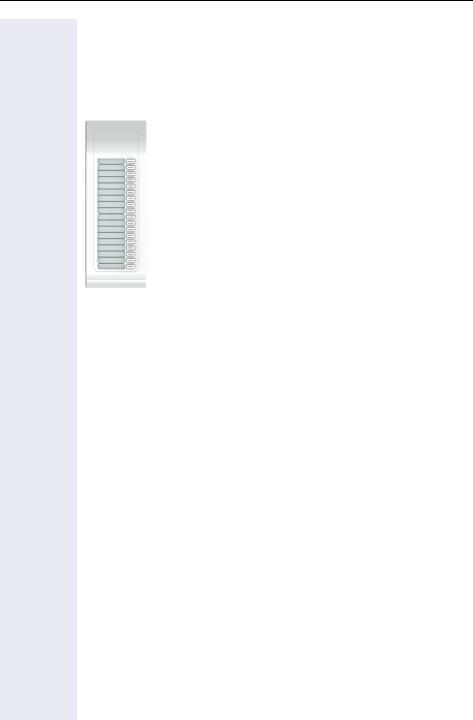
Getting to know your OpenStage phone
OpenStage Key Module 15
The OpenStage Key Module 15 is a key module attached to the side of the phone that provides an additional 18 illuminated, programmable sensor keys.
Like keys on the phone, these keys can be programmed and used according to your needs
You can only attach one OpenStage Key Module 15 to your OpenStage 40. You cannot mix the OpenStage Key Module 15 with the
OpenStage Key Module 40.
15

Getting to know your OpenStage phone
OpenStage Busy lamp field 40
Your OpenStage 40 T can be configured as an attendant console in conjunction with an OpenStage Busy lamp field 40 (ask your service personnel).
The OpenStage Busy lamp field 40 is a key module attached to the side of the phone, that provides 90 illuminated, programmable keys.
Like keys on the phone, these keys can be programmed and used according to your needs Æ page 19.
You can attach one OpenStage Busy lamp field 40 to your
OpenStage 40 T.
Key label
Your OpenStage Busy lamp field 40 is delivered with label strips. Write functions or names in the white fields on the label strips.
Alternatively, you can use the Key Labeling Tool to conveniently create new label strips. You can find this including instructions at http://wiki.siemensenterprise.com/index.php/Key_Labelling_Tool .> .
Lay the labeled strips on the key fields and place the transparent cover over them (rough side up).
16
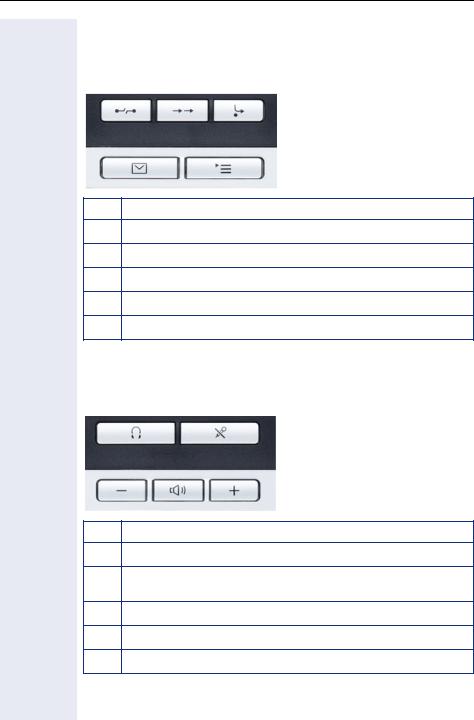
Getting to know your OpenStage phone
Keys
Function keys
Key Function when key is pressed
s End (disconnect) call Æ page 38.
, Redialing Æ page 37.
r Button for call forwarding (with red LED key)[1] Æ page 41.
O Open mailbox (with red LED key) Æ page 26.
NOpen telephone menu (with red LED key) Æ page 28.
[1]If the LED key flashes on the phone, your phone was configured as a forwarding destination.
Audio keys
Key Function when key is pressed
oActivate/deactivate headset Æ page 46.
pActivate/deactivate microphone (also for speakerphone mode) Æ page 38.
- Set volume lower and contrast brighter Æ page 123.
n Turn speaker on/off (with red LED key) Æ page 34.
+ Set volume louder and contrast darker Æ page 123.
17
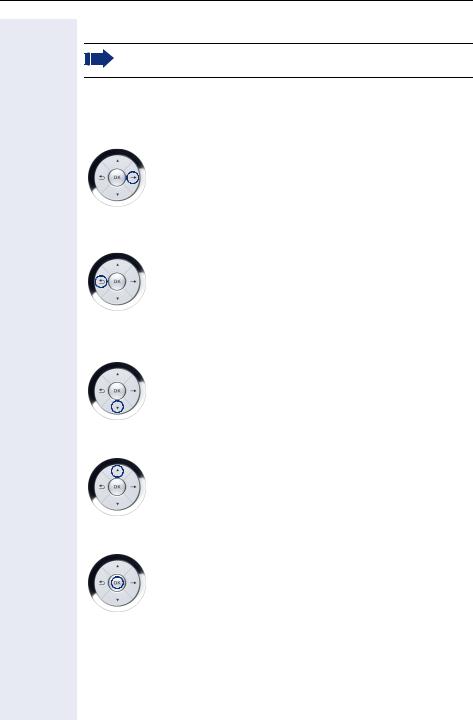
Getting to know your OpenStage phone
5-way navigator
Remove the protective film from the ring around the 5-way navigator before using the phone.
With this control, you can manage most of your phone’s functions, as well as its displays.
Operation |
|
Functions when key is pressed |
|
|
|
|
|
|
|
In idle mode: |
|
|
Press c |
• Open the idle menu Æ page 23 |
|
|
In lists and menus: |
||
|
|
||
|
|
• Go to next level |
|
|
|
You can now access a context menu: |
|
|
|
• Open the context menu |
|
|
|
|
|
|
|
In lists and menus: |
|
|
Press a |
• go back one level or go back to the |
|
|
|
telephony interface by pressing |
|
|
|
|
several times |
|
|
During en-bloc dialing: |
|
|
|
• Delete character to the left of the |
|
|
|
|
cursor |
|
|
|
|
|
|
In idle mode: |
|
|
Press d |
• Open the idle menu Æ page 23 |
|
|
In lists and menus: |
||
|
|
||
|
|
• |
Scroll down |
|
|
• Long press (key held down): jump |
|
|
|
|
to the end of the list/menu |
|
|
|
|
|
|
In idle mode: |
|
|
Press b |
• Open the idle menu Æ page 23 |
|
|
In lists and menus: |
||
|
|
||
|
|
• |
Scroll up |
|
|
• Long press (key held down): jump |
|
|
|
|
to the start of the list/menu |
|
|
|
|
|
|
In idle mode: |
|
|
Press i |
• Open the idle menu Æ page 23 |
|
|
Entry selected: |
||
|
|
||
|
|
• |
Perform action |
|
|
|
|
18
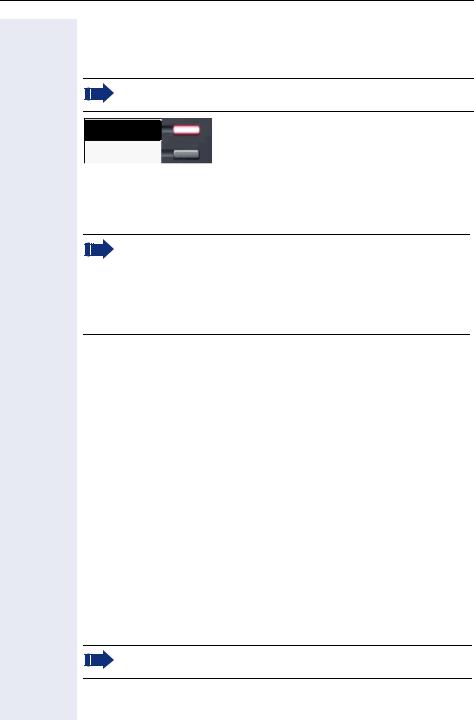
Getting to know your OpenStage phone
Programmable sensor keys
Your OpenStage 40 T has six illuminated sensor keys. You can assign functions and phone numbers to them on two levels.
Increase the number of programmable sensor keys by connecting a key module Æ page 14.
Mirea, Ch
Layer 1
Depending on how they are programmed, you can use the sensor keys as:
•Function keys Æ page 72
•Repdial keys Æ page 77
•Procedure keys Æ page 75
You can program all programmable sensor keys (except "Shift") on two levels. The Shift key Æ page 72 must be configured for this, and extended key functionality must be active (contact your service personnel).
In addition to functions and procedures, external phone numbers and internal numbers without LED display can also be saved on the second level Æ page 77.
Touch the key to activate the programmed function or dial the stored number.
Press the key to open a menu for programming it Æ page 75.
A label for the function is displayed to the left of the key. You can define the labeling according to your requirements Æ page 78.
The status of a function is shown by the LED on the corresponding sensor key.
Meaning of LED displays on function keys and DSS keys
LED |
Meaning of function key |
Meaning of DSS key |
|
|
|
|
|
S |
Off |
The function is deactivated. |
The line is free. |
T |
Flashing[1] |
Indicates the function sta- |
The line is busy. |
|
|
tus. |
|
R |
On |
The function is activated. |
There is a call on the line. |
[1]In this manual, flashing sensor keys are identified by this icon, regardless of the flashing interval. The flashing interval represents different statuses, which are described in detail in the corresponding sections of the manual.
The programmable sensor keys on multi-line phones function as trunk keys Æ page 104.
19

Getting to know your OpenStage phone
Keypad
In cases where text input is possible, you can use the keypad to input text, punctuation and special characters in addition to the digits 0 to 9 and the hash and asterisk symbols. To do this, press the numerical keys repeatedly.
Example: To enter the letter "h", press the number 4key on the keypad twice.
Alphabetic labeling of dial keys is useful when entering vanity numbers (letters associated with the phone number’s digits as indicated on the telephone spell a name; e.g. 0700 - PATTERN = 0700 - 7288376).
Multi-function keys
Function |
) |
( |
Long press |
Turn ringtone on/off |
Turn phone lock on/off |
(key held down) |
Æ page 125. |
Æ page 86. |
Text input Æ page 21 Next letter in upper case. Delete character.
Character overview (depends on the current language setting)
Key |
1x |
2x |
3x |
4x |
5x |
|
|
|
|
|
|
1 |
[1] |
1 |
|
|
|
2 |
a |
b |
c |
2 |
|
3 |
d |
e |
f |
3 |
|
4 |
g |
h |
i |
4 |
|
5 |
j |
k |
l |
5 |
|
6 |
m |
n |
o |
6 |
|
7 |
p |
q |
r |
s |
7 |
8 |
t |
u |
v |
8 |
|
9 |
w |
x |
y |
z |
9 |
0 |
+ |
. |
- |
0 |
|
) |
[2] |
|
|
|
|
( |
[3] |
|
|
|
|
[1]Space
[2]Next letter in upper case
[3]Delete character
20

Getting to know your OpenStage phone
Text input
The current label appears on the first line. Delete it with the (key before entering new characters.
Enter the required characters via the keypad.
Select the functions using the keys dand b.
Confirm your entry with i.
Example: Changing the key label Æ page 78.
L1 label: Ma |
|
|
|
Characters entered |
|||
|
|
|
|||||
|
|
Save |
|
|
|
Save entry |
|
|
|
|
|
|
|||
|
|
|
|
|
|
|
Delete character[1] |
|
|
#=Delete Character |
|
|
|||
|
|
|
|
||||
|
|
|
|
|
|
|
|
previous
Exit
[1] Alternatively, press the key (
21
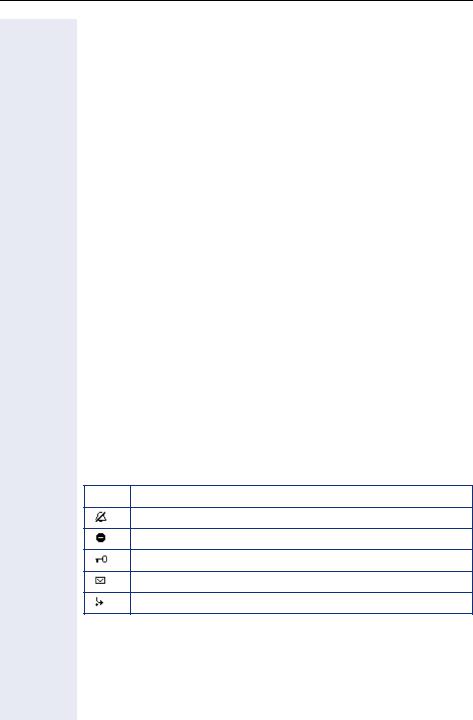
Getting to know your OpenStage phone
Display
Your OpenStage 40 T comes with a tilt-and-swivel black-and-white LCD display. Adjust the tilt and contrast to suit your needs Æ page 123.
Idle mode
If there are no calls taking place or settings being made, your
OpenStage 40 T is in idle mode.
|
|
|
|
|
|
|
|
|
Status bar |
|
|
|
|
|
|
|
|
|
|
10:29 |
|
Wed 28.Nov.07 |
DoNotDis- |
|
|
Sensor key labels |
|||
|
|||||||||
|
|
|
|
|
|
Mirea, Ch. |
|
|
Æ page 78 |
|
|
|
|
|
|
|
|
|
|
|
S |
Toussaint. |
|
|
|
||||
|
|
|
|
|
|
Rüscher |
|
|
|
|
|
F 07 |
|
|
|
|
Alerts (messages, call |
||
K 100168 |
|
|
Stahl, Ing |
|
|
forwarding active) |
|||
|
|
|
|
|
|
|
|
|
|
220870 |
|
|
|
g |
Layer 2 |
|
|
Open the idle menu |
|
|
|
|
|
|
|||||
|
|
|
|
|
|
|
|
|
|
|
|
|
|
|
|
|
|
|
Æ page 23 |
|
|
|
|
|
|
|
|
|
Own phone number |
The left area contains the status bar on the first line, followed by a five-line field for additional displays. ?
A logo is displayed in the middle; it can be set up by your service personnel.
Icons that appear under the logo inform you about callback requests, voice messages, and activated call forwarding.
The right area shows the labels of programmable sensor keys.
Explanation of the icons
Icon Explanation
The ring tone is deactivated Æ page 125.
The "Do not disturb" function is activated Æ page 83.
The phone lock is activated Æ page 86.
You received new voice messages Æ page 26.
Call forwarding is active Æ page 41.
22

Getting to know your OpenStage phone
Idle menu
When in idle mode, press a key on the 5-way navigator Æ page 18 to display the idle menu. You can call up various functions here. It includes selected functions from the Program/Service menu Æ page 28.
The idle menu may contain the following entries:
•Caller list
•Forwarding on
•Lock phone
•DND on[1]
•Advisory msg. on
•Ringer cutoff on
•Send message
•View sent message[2]
•View callbacks[3]
•Directory
•HF answerback on
•Suppress call ID
•Waiting tone off
•DISA intern
[1]Must be activated by service personnel.
[2]Only appears when there are messages that the recipient has not yet viewed
[3]Only appears if callback requests are saved
23
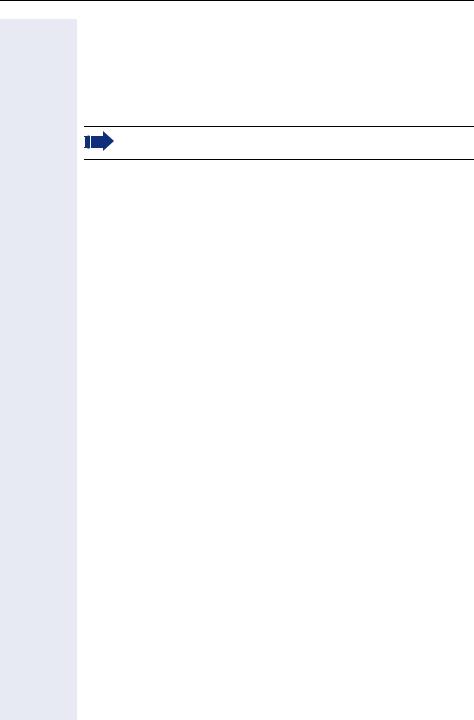
Getting to know your OpenStage phone
Telephony dialogs
Connection-dependent conditions and situations, e.g. when your telephone rings, when dialing a number, or during a call, are depicted graphically on the display.
Situation-dependent functions that automatically appear on the display can be selected and activated with the 5-way navigator Æ page 18.
The scope and type of functions that may be offered automatically varies.
When an arrow appears to the right of a selected entry, then another menu level is available, which you can select with the ior ckeys Æ page 18.
Appearance during dialing
Example: You have deactivated "Call preparation" Æ page 29, have lifted the handset, or pressed the speaker key.
10:29 |
Wed 28.Nov.07 |
|
|
|
|
|
||
|
Please dial |
|
|
|
|
|
|
Status |
|
|
|
|
|
|
|
||
|
Directory |
|
|
|
|
|
|
Stored numbers |
|
|
|
|
|
|
|
|
|
|
Caller list |
|
|
|
|
|
|
|
|
|
|
|
|
|
|
|
|
Appearance during en-bloc dialing
Example: You have deactivated "Call preparation" Æ page 29 and are entering a number.
10:29 |
Wed 28.Nov.07 |
|
|
|
|
||||
|
22 |
|
|
|
|
|
|
|
Digits already entered |
|
|
|
|
|
|||||
|
Please dial |
|
|
|
|
Dial the phone number |
|||
|
|
|
|
||||||
|
|
|
|
|
|
|
|
|
|
|
Cancel |
|
|
|
|
|
|
Cancel entry |
|
|
|
|
|
|
|
|
|||
|
|
|
|
|
|
|
|
|
|
24
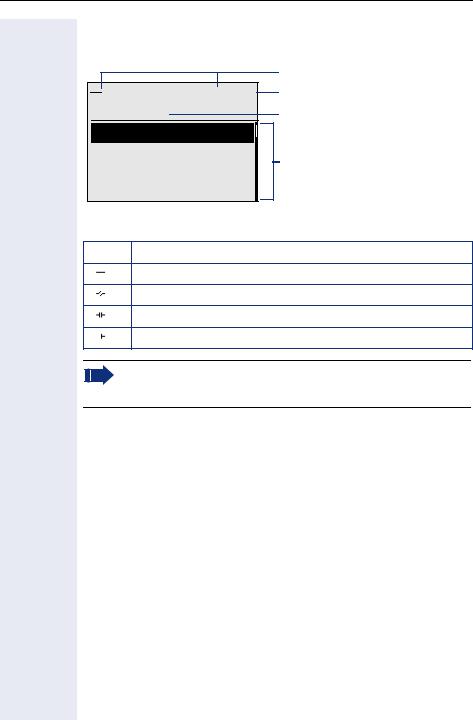
Getting to know your OpenStage phone
Appearance during an ongoing call
Example: You are connected with a caller.
Smith Michael |
3:16 |
 100168
100168
Consultation
Start conference
Start transfer
Directory
Icons for frequent call states
Icon indicating call status
Call duration
Current connection
Options relevant to situation; scroll bar shows that more options are available.
Icon Explanation
The call is active.
The call has been disconnected.
You have placed the call on hold (e.g. consultation hold).
Your call partner has placed the call on hold.
Detailed descriptions of the various functions can be found in the sections "Making calls – basic functions" Æ page 32 and "Making calls – enhanced phone functions" Æ page 46.
25
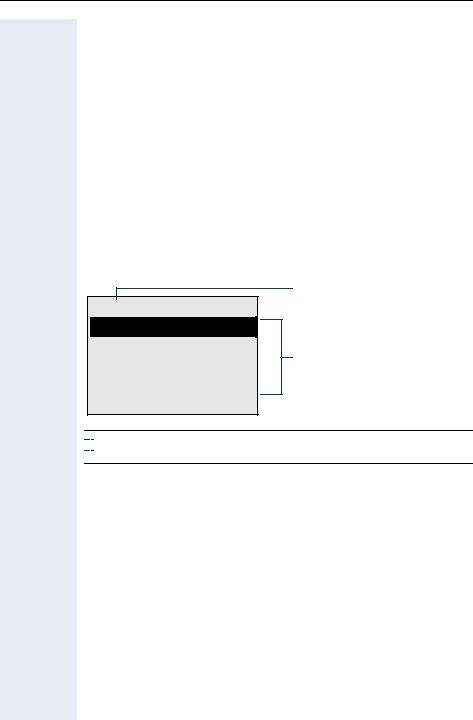
Getting to know your OpenStage phone
Mailbox
Depending on the type and configuration of your communications platform (contact the relevant service personnel), messages from services, such as, HiPath Xpressions are displayed in this application in addition to messages received.
Messages
You can send short text messages to individual internal stations or groups.
In idle mode (Æ page 22) the following signals alert you to the presence of new messages:
•Okey LED lights up
•Display Æ page 22.
Press the mailbox key O.
Example:
Caller ID
Msg. from: Coco Chanel
Message sent
Call sender
Possible functions
Delete
Exit






 For a description of how to edit the entries Æ page 91.
For a description of how to edit the entries Æ page 91.
Voicemail
If your telephone is connected to a voicemail system (such as Entry Voice Mail), the Mailbox key will also light up to alert you to any messages that have arrived.
To play back your voicemail, follow the instructions on the display.
26

Getting to know your OpenStage phone
Caller list
If you are unable to accept an external or internal call, the call attempt is stored in the caller list.
You can also store external calls that you have answered in the caller list (contact your service personnel).
Your telephone stores up to ten calls in chronological order. Each call is assigned a time stamp. The most recent entry not yet answered in the list is displayed first. Multiple calls from the same caller do not automatically generate new entries in the caller list. Instead, only the most recent time stamp for this caller is updated and its number incremented.
The caller list is automatically displayed Æ page 23 in the idle menu Æ page 51.






 Callers with suppressed numbers cannot be saved in the call log.
Callers with suppressed numbers cannot be saved in the call log.
Information is displayed regarding the caller and the time at which the call was placed.
Example:
13:47 |
Wed 29.Nov.08 |
|
|
|
|||
Calls for Coco Chanel: |
|
|
|
Own ID |
|||
|
|
|
|||||
Dalai Lama |
|
|
|
|
|
Caller ID |
|
|
|
|
|||||
0220870 |
|
|
|
|
|
Number of calls, time, date |
|
3x: 13:55Wed 23.Nov 08 |
|
|
|||||
|
|||||||
Call |
|
|
|
|
|
|
Possible functions |
|
|
|
|
|
|
||






 For a description of how to edit the caller list Æ page 51.
For a description of how to edit the caller list Æ page 51.
27
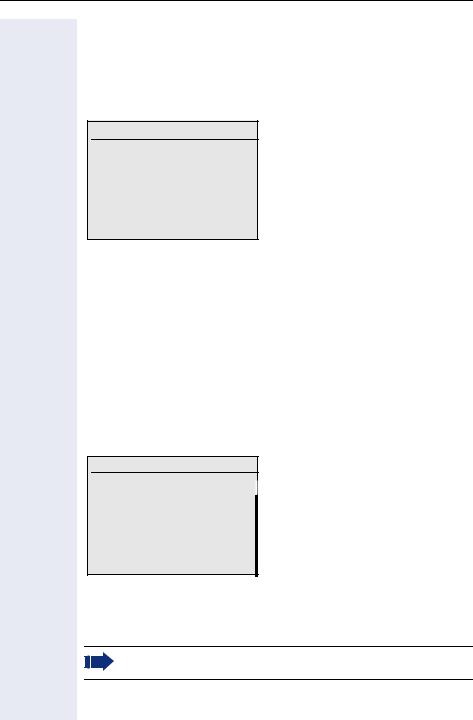
Getting to know your OpenStage phone
Menu
With the menu key N, you can access your communications system’s service menu or make telephony-related settings.
The LEDs associated with the menu key Nand the loudspeaker key nstay red as long as you are in the menu.
Menu
|
Program/Service |
g |
|
||
|
|
|
|
Block Dialing |
Off g |
|
Call Pop Up |
On g |
Program/Service menu
Accessing the menu
There are three ways to open the Program/Service menu on your communication system:
1.Press the menu key Nand confirm the selected entry "Service Menü" with the key i.
2.Press cand select a function from the idle menu Æ page 23.
3.In idle mode, press (or )and the code for the function you want.
Example:
Program/Service:
Destinations |
g |
Feature Settings |
g |
Use speed dialing |
|
Prog. feature key |
|
PIN and Authorization |
g |
The menu structure comprises several levels. The first line in this structure shows the menu currently selected while the second line shows an option from this menu. An arrow next to an entry indicates additional options for this entry.
For an overview of the maximum functions available, with corresponding codes, see Æ page 136.
28
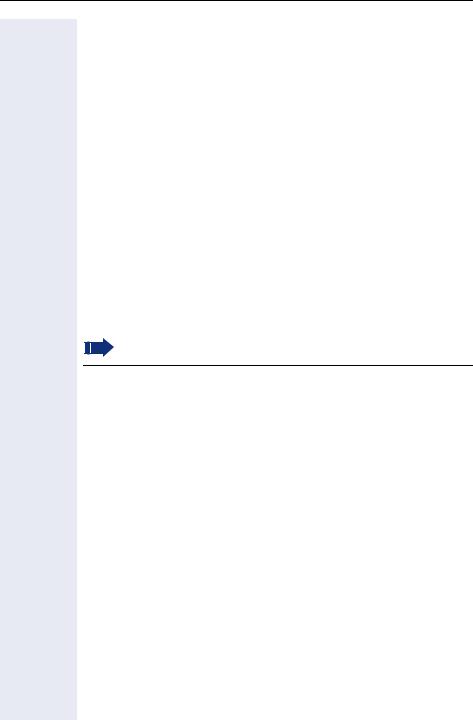
Getting to know your OpenStage phone
Call preparation
Activate the function "Call preparation" to use en-bloc dialing on your OpenStage 40 T.
This means: You engage the line only after you have fully entered the number and confirmed.
Activate/deactivating en-bloc dialing
Press the Nmenu key, select "Block Dialing On" or "Block Dialing Off" using the 5-way navigation key and confirm with i.
Example: "Call preparation" menu view.
|
Block Dialing |
On |
|
current status |
|
|
|||
|
Block Dialing |
On |
|
|
|
Block Dialing |
Off |
|
|
|
|
|
|
|
|
|
|
|
|
An example of the display during en-bloc dialing is on Æ page 24. For a description of en-bloc dialing, see Æ page 50.
29

Getting to know your OpenStage phone
Call pop-up
Activate the function "Call pop up" so that if you are on a call you are notified on the display by a popup about a second incoming call.
Activating/deactiviating call pop up
Prerequisite: "Second call" must be activated Æ page 60.
Press the Nmenu key, select "Call Pop Up On" or "Call Pop Up Off" using the 5-way navigation key and confirm with i.
Showing and processing a second call
Example: second call when call pop-up is on
|
|
|
Smith Michael |
3:16 |
|
Information about current call |
|||
|
|
|
|
||||||
|
|
|
|
|
100168 |
|
|
|
|
|
|
|
|
|
|
|
|
||
|
|
|
|
|
|
||||
|
|
|
|
|
|
|
|
|
|
|
|
|
YJane Fonda |
|
|
Pop up window with caller ID |
|||
|
|
|
|
|
|||||
|
|
|
|
|
|
|
|
|
for incoming call |
|
|
|
|
|
|
|
|
|
Show menu |
|
|
|
Display |
|
|
|
|||
|
|
|
|
|
|||||
1.While talking to the first party confirm the entry "Display" using the i key.
2.From the menu that appears, select an action for dealing with the second party:
–Consultation Æ page 39
–Take call Æ page 60
–Start conference Æ page 64
–Start transfer Æ page 40
–Phonebook Æ page 52
–Put the call on hold
–Quit and return
30
